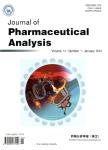Study on screening potential allergenic proteins from infant milk powders based on human mast cell membrane chromatography and histamine release assays
Study on screening potential allergenic proteins from infant milk powders based on human mast cell membrane chromatography and histamine release assays作者机构:School of Pharmacy Xi'an Jiaotong University Linyi Institute for Food and Drug Control Shaanxi Engineering Research Center of Cardiovascular Drugs Screening & Analysis
出 版 物:《Journal of Pharmaceutical Analysis》 (药物分析学报(英文版))
年 卷 期:2019年第9卷第1期
页 面:55-61页
核心收录:
学科分类:0710[理学-生物学] 1007[医学-药学(可授医学、理学学位)] 1002[医学-临床医学] 0817[工学-化学工程与技术] 0703[理学-化学] 10[医学] 0702[理学-物理学]
基 金:supported by the National Natural Science Foundation of China (No: 81230079, 81102414, 81227802) the Natural Science Basic Research Plan in Shaanxi Province of China (Program No. 2017JQ8024)
主 题:Allergenic proteins Cell membrane chromatography Milk powders
摘 要:Cow s milk allergy is mainly observed in infants and young children. Most allergic reactions affect the skin, followed by the gastrointestinal and respiratory systems. Conventional diagnosis is based on positive allergy studies and evaluation of parameters including IgE and IgG1 levels, acute allergic skin response and anaphylactic shock reactions. We developed a cell membrane chromatographic(CMC)method based on human mast cells(HMC-1) for screening potential allergens in infant formula milk powders(IFMP). HMC-1 cell membranes were extracted and mixed with silica to prepare cell membrane chromatography columns(10 mm ? 2 mm i.d., 5 mm). Under the conditions of 0.2 mL/min flow rate and214 nm detection wavelength, human breast milk showed no retention. However, IFMP showed clear retention. The retained fractions were collected and analyzed through matrix-assisted laser desorption/ionization time of flight mass spectrometry(MALDI-TOF-MS). Four major milk proteins, i.e., α-casein, β-casein, α-lactalbumin, and β-lactoglobulin A, were identified. Furthermore, these proteins and β-lactoglobulin B showed clear retention on HMC-1/CMC columns. To test the degranulation effects of the five proteins, histamine and β-hexosaminidase release assays were carried out. All five proteins induced HMC-1 cells to release histamine and β-hexosaminidase. Also, we established a reversed phase liquid chromatographic(RPLC) method for the determination of the five proteins in IFMP and the results showed that 90% proteins in IFMP were α-casein and β-casein. We concluded that cow s milk proteins may be potential allergens and caseins cause more β-casein allergic risk than other proteins. This conclusion was consistent with other studies.



